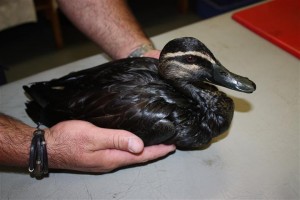Tuesday 13th March 2012 – AMWRRO attended the huge fire at the Mulhern’s Waste Oil depot (Wingfield) due to several birds being affected by oily slugs that washed through the drain system into a small pond that had been sectioned off to stop the oil from reaching the wetland area. In the middle of this pond was a small section of reeds that ducks had apparently entered into as the water level slowly got higher and higher.
Despite AMWRRO remaining on site for over 10 hours and well into the night; these birds were never seen by AMWRRO personnel.
The following morning Wednesday 14th March 2012 AMWRRO returned to check the water level in the pond only to find it hadn’t dropped, again the birds were not seen despite getting within metres of the reeds. That afternoon AMWRRO attended again with no birds in sight.
Late Wednesday afternoon/evening Adelaide received over 25mls of rain as several large storm cells moved across the state. AMWRRO feared the water level in this pond would breach containment lines put in place and attended to check for birds and to make sure the 4 booms put in place to stop the oil from hitting the wetlands did not come adrift.
Unfortunately on arrival at 20:00 our fears became a reality with two booms completely adrift and the other two held under the water level or snagged on sandbags; allowing hundreds of thousands of liters of water and oil to flow directly into the Barker Inlet Wetland region.
AMWRRO immediately notified state government agencies responsible for the booms; the Marine Safety – Oil Response Unit of which did nothing due to the time of day and weather conditions. The Marine Safety Unit did not notify the EPA. AMWRRO contacted the EPA directly and informed them of this serious situation and requested they attend to reset booms in order to stop the remaining oil from hitting the sensitive wetlands. The EPA did attend but without the support of the Marine Safety Unit were unable to reset the booms in time. The remaining oil flowed directly into the Barker Inlet Wetlands.
AMWRRO’s emergency response personnel were contacted Wednesday night at 20:30 and all hands were on deck the following morning to start the rescue operation.
Thursday morning 15 AMWRRO personnel assembled at Torrens Island for briefing and were on site by 07:30 with boats launched and the AMWRRO clinic prepped for oiled birds and wildlife. Additional AMWRRO crews were placed on standby in case the situation turned from bad to worse.
Vessel operations worked in conjunction with land based crew and together AMWRRO combed the entire wetland area for oiled birds. Over 25 birds were seen to be affected by oil  – yet could still fly or dive when approached. These birds will be closely monitored over the next few days/weeks as they will eventually drop once their stomachs are filled with this toxic oil as a consequence of preening oil affected feathers.
– yet could still fly or dive when approached. These birds will be closely monitored over the next few days/weeks as they will eventually drop once their stomachs are filled with this toxic oil as a consequence of preening oil affected feathers.
AMWRRO personnel finished on site operations and returned to Torrens Island to start scrubbing those birds that were rescued.
Friday morning, AMWRRO personnel again attended the Barker Inlet Wetlands to recover what birds were found on high ground and in the water – now suffering from hypothermia and toxic ingestion. These birds were immediately taken into care and treated. Unfortunately for some; the toxic mix of oil, solvents and other waste products proved too much for their internal organs and went downhill overnight considerably – one pacific black duck was euthanased due to its condition spiralling downhill overnight. A post-mortem examination will be performed at a later date to confirm along with toxicology tests.
Saturday and Sunday AMWRRO crews combed the wetlands for oiled birds again taking all that were found into care for immediate treatment and scrubbing. Most of these birds have recovered well from treatment but some have also died due to the stress of the whole ordeal in conjunction with a supressed immune system and toxic ingestion.
This week AMWRRO personnel will continue to rescue birds from this area, unfortunately due to these birds still being able to fly; many birds have now moved into other areas that are not contaminated – making it very difficult to find let alone rescue and treat before it’s too late.